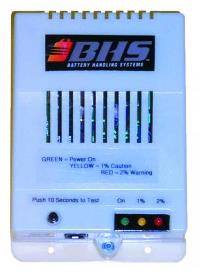We use cookies to make your experience better. To comply with the new e-Privacy directive, we need to ask for your consent to set the cookies. Learn more.
4 Important Purchasing Factors for Battery Room Hydrogen Monitoring Equipment
Electric forklifts are an extremely safe technology — with an exceptionally safe power source. Even so, all heavy duty equipment needs to be handled with appropriate precautions, and appropriate battery room monitoring equipment will help you keep your operation safe and productive.
In order to comply with relevant codes and protect against hydrogen gas accumulation, fires and other dangers, you’ll need to consider the following:
The Physical Design of the Battery Room
All batteries naturally release hydrogen, which can build up to dangerous levels without proper ventilation.
Depending on the design of your forklift battery room, you may require multiple monitors; hydrogen rises and can accumulate in air pockets in different parts of the room. Before you purchase monitoring equipment, take a look at the room. Look for raised ceilings or areas that might be poorly ventilated and plan on placing additional monitors as needed.
Ease of Integration
Make sure that your detectors have a consistent and dependable power source. Many monitors are available in both AC- and DC-powered designs, which can allow for easier installation in your facility.
Look for monitors that will integrate easily with your current venting system. Hydrogen gas alarms should monitor continuously and should be equipped with relays to trigger venting when levels exceed a certain threshold. Multiple relays are essential if you run a larger battery room.

Alarm Visibility and Audibility
Your alarms should be loud enough for all employees to hear, so look for decibel ratings. As an example, the BHS Hydrogen Gas Detector (HGD-1)has an 80 decibel alarm, which is adequate even in louder workspaces.
Visual alarms are also helpful, especially in environments with substantial ambient noise. Most newer alarms incorporate LED lighting as a clear indicator of high gas concentrations.
If an area contains multiple alarms, make sure that workers understand the differences between the units to ensure an adequate response. For example, carbon monoxide and fire detectors should create distinct audible cues; alarms that issue verbal warnings are especially useful in this respect.
Hydrogen Gas Alarm Sensitivity
Hydrogen-air mixtures can ignite and combust easily; hydrogen and air can ignite on contact with only 10 percent of the energy that causes gasoline-air mixtures to combust. Hydrogen also has a fairly wide flammability range when combined with air.
Even so, hydrogen can be ignited by static sparks and small flames in relatively low concentrations, so the sensitivity of your detector is an extremely important consideration. The International Fire Code (IFC) and the National Fire Protection Association (NFPA) permit a maximum hydrogen level of 1.00 percent by volume, so the best practice is to choose an alarm that provides visual notifications of some kind at 1.00 percent. Alarms should sound if concentrations reach 2.00 percent.
Your obligation doesn’t end when you purchase hydrogen monitors and fire alarms; to ensure safety, you need to set up regular checks for all crucial safety equipment. Make sure that your staff is trained to deal with hydrogen accumulation, and make sure that they understand the importance of monitoring; alarms aren’t especially useful if workers don’t pay attention to them.
When properly implemented, hydrogen detectors are extraordinarily cost effective, and they can even allow for a reduction in insurance premiums in some instances. Be sure to research product features before making your purchase, and you’ll run an even safer — and more productive — battery room.
References:
Osha.gov,. 'Powered Industrial Trucks Etool: Types & Fundamentals - Power Sources: Electric'. N.p., 2015. Web. 29 July 2015.
